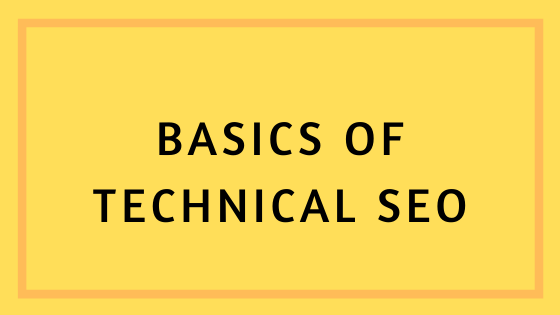The Basic Of Technical SEO: A complete Technical SEO guide
What is Technical SEO ? What are some difference
Imagine this scenario where you have just created an amazing video on your website, conducted extensive digital marketing to create the awareness of your video, the date of the launch has gone viral, and people are waiting impatiently to watch the video. Then the d-day comes, and it takes your website 10 seconds plus to load. What do you suppose will happen?
First, your visitors will get tired of waiting for the page to load, your bounce rate will increase, and Google will penalize your site.
This scenario is caused by a faulty technical SEO; and it also brings to fore, the vital importance of performing it on your website. What is technical SEO, how relevant is it for websites, what are the elements that make up a good technical SEO?
What is a technical SEO?
Russ Jones of TECH SEO provides this interesting definition, he says
“any sufficiently technical action undertaken with the intent to improve search results”.
Russ Jones definition may be interesting, but it failed to pin-point some significant elements of technical SEO like Alexis Sanders of Merkle, he said
“Technical SEO covers the crawl, index, and render the portion of the “crawl, index, rank” model.
It is important to conduct technical update SEO on your website because technical problems undermine the usability of your web pages. Everything that works behind to scene to make your website SEO requires some technical know-how.
For instance, producing basic content and making it search engine optimized to appear and rank high in search engine result requires different skills. Unfortunately, marketers avoid making the necessary modification that makes website contents relevant just because they lack technical knowledge.
The purpose and work of technical SEO:
- To ensure that search engine bots can crawl or find your page which includes status codes, information structure, robots.txt, facets, status codes, and sitemaps.
- To ensure that your web page is easily indexed by search engine spider
- To make bots render your page, and that includes, DOM, JavaScript, and page speed
- To ensure that the content of your pages are easily comprehensible by bots
- To ensure that your web pages are giving out the right signals to search engine regarding handling content ranking
- And finally, to ensure that your page is ranking worthy.
Generally speaking, if your website is not performing well in search engines ranking, the reason is mostly tied to a failed technical SEO job.
To a layman that is still confused about the meaning of skilled SEO practice, here is a simpler definition:
It is the optimization of your website for easy crawling and indexing by search engine bots, and the purpose is to enhance search visibility and website usability.
Another way to understand it is when you compare skilled SEO to the function of a skeleton in the human body. The skeleton provides protection, shape, support, and structure to the body; this pretty much summarizes the benefit of skilled or technical SEO.
Also, like the skeleton that is not visible to the eyes, a technical SEO job is invisible, but the impact can only be seen through website performances.
The elements of technical SEO:
Mobile friendly:
Many people own cell phones and are literally glued to it they act as if it’s their life. Every day, people are buying cell phones including those who already have one; some have two or more cell phones, while some habitually change their phones frequently.
The use of a mobile phone for online browsing will increase in the 2020s, Google and other search engines recognized this trend; therefore, they have been working hard over the years to adjust their search algorithms to show this mobile phone craze.
In 2015, they introduced mobile phone related updates. In 2016, an indexing plan for mobile was introduced.
Mobile phone traffic is currently more popular than desktop traffic. People are now conducting searches through their phone 57% of traffics and visit to retail stores is from mobile gadgets.
Base on the brief illustration above about mobile phone usage, you can see why making your web pages mobile-optimized is important.
The update by Google makes it so, and because Google controls 93% of the search engine space, everyone including search engines is compelled to comply with their mobile algorithm update dictates.
How can a website become optimized for mobile traffic?
The simpler way is to create a dynamic or responsive website that can adapt to screen size.
2. Website Speed:
How fast your website loads is a critical requirement for SEO ranking. It doesn’t matter if you are operating from a mobile or desktop device, your web page speed is crucial.
Website visitors generally are impatient and will simply leave a website for another if it takes too long to load; this action is called pogo-sticking, and Google hates it. A page that takes 10 seconds to loads increases bounces rate by 132%. A slow-loading page is one of the major reasons people abandon a website for another.
Google reacts to pogo-sticking by reducing the ranking potential of a website. Technical SEO will ensure that your page load time is fast.
Reasons websites have speed problems are:
- Images are poorly optimized or too big
- No web content compression
- Too many CSS image request on pages
- No caching of information
- Too many plugins installed on a website
- CDN is absent for static files
- Slow web host connection
3. Website errors:
Another aspect that technical search engine optimization deals with is site errors. The fact is website mistakes will tank your ranking; they are simply frustrating; everyone hates it, so should you. What causes a website error?
Most often, mistakes on the website are caused by broken links, missing pages, and incorrect redirects. To handle errors on websites, keep this in mind.
You have to handle 404 errors. Imagine clicking a website, and what you get is a 404 error. This gives a website a bad image and low credibility. Google simply hates it.
Look for broken links and fix them:
A broken link is another aspect that requires technical SEO. Google hates broken links because it’s annoying. Envisage clicking on a link with the hope of reading an interesting article, and what happens? Nothing, no article to read; this is very frustrating especially if the situation persists on the same page. The next sensible action is you stop visiting that website.
You can fix this problem by locating broken links; it’s not complicating. Also, avoid this problem by monitoring your link building effort.
There are tools you can use online to discover and fix broken links.
4. Duplicate contents:
Producing content that is similar to another in several websites is called duplicate content, the crime is plagiarism. Duplicate content can be in the form of written content like articles, blog posts, images, videos, etc. Many webmasters use duplicate or plagiarized content on their website, and Google frowns against this practice – no one likes to read or view the same contents seen two or more websites.
Check duplicate contents with Copyscape and avoid Google punishment.
5. Avoid crawl errors with sitemaps:
Never overlook crawl errors. What is a crawl error? It simply indicates that bots crawling your website discovers something amiss that will affect the ranking of your website. You can prevent this problem with sitemaps. Add a working sitemap on your website.
A sitemap makes the crawling of your website easy, use XML sitemap on your website, and when you are done, present it to the search engines. After you have added it to the search engine, Google will easily index your pages.
6. Long and confusing URL:
Does your URL have a query stricture at the end? If it does, take it off, because, it will constitute an indexing problem. Other problems that can cause index difficulties are, missing alt tags, title tags, and long or missing meta descriptions.
7. Optimize images:
Having responsive visual content that enhances users’ experience is very portent for on-page and marketing SEO.
An abnormally large image can affect page load-time, make your website less mobile-friendly, and eventually, affect your Google ranking.
Apart from abnormal sized images, broken images can also damage user experience hence increasing the bounce rate.
Upload only top-quality images and use the Smush tool for compressing and optimization.
The Smush tool is a plugin that helps to reduce the size of your images to a point it doesn’t slow down your pages. T
he wonderful part about the tool is that it works without changing the quality of your pix.
Another tool is called Super Cache, used for producing pictures of your sites. It can reduce the number of data your website utilizes and increase your website load time.
8. International SEO:
Some websites target international or global users. Such websites need to optimize their web pages to allow easy international user accessibility.
If your global target audience cannot access your sites, they will abandon it for another; this invariable leads to pogo-sticking that Google hates so much.
You can fix this technical issue through these 2 avenues:
Country:
A website that targets international audiences are nick-named multi-regional sites; to avoid SEO issues, they should select a URL that allows easy domain targeting. Using a “ccTLD like .ca, .uk,” or a country- exact subfolder like “.com/ca” is recommended.
Language:
If your sites target people of different languages, add “hreflang tag to notify Google that your pages have a duplicate for another language.
The basics of Technical SEO involve enhancing your website usability. It is a behind the scene optimization of your website structure and contents that makes indexing easy and Google ranking possible. It makes website responsive promoting excellent user experience.





Thanks for this. I really like what you’ve posted here and wished you the best of luck with this blog!
Wonderful post, fascinating to read. I love to read such an excellent article. Thanks!
… [Trackback]
[…] There you will find 6275 more Infos: thedigitalchapters.com/the-basic-of-technical-seo/ […]
commendable work, cheer to the author!
thanks to the author for the perfect information, rightly stated and located with minimum or negligible confusion.